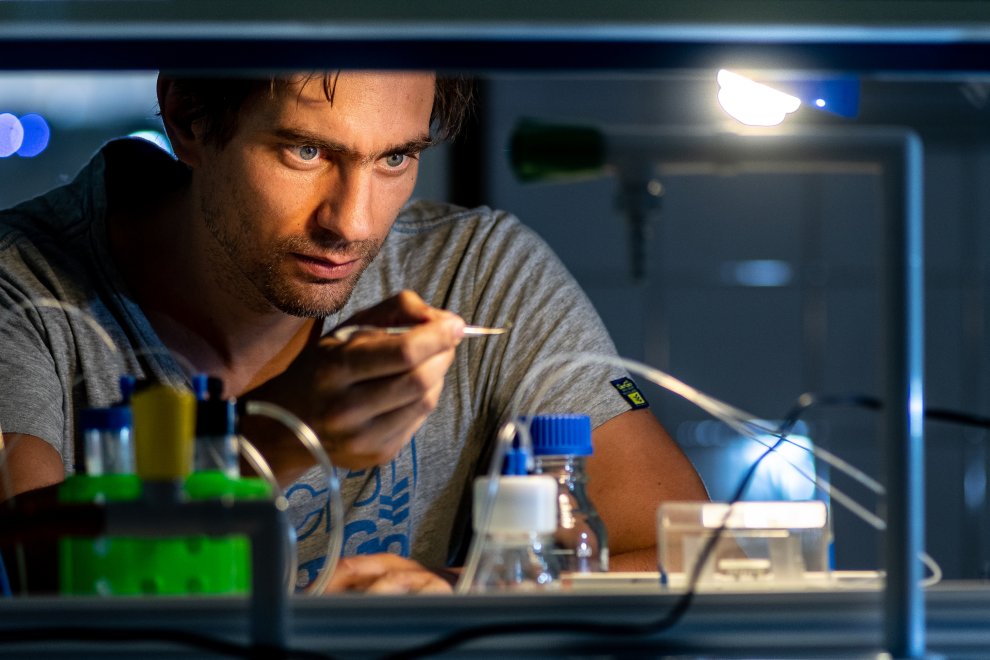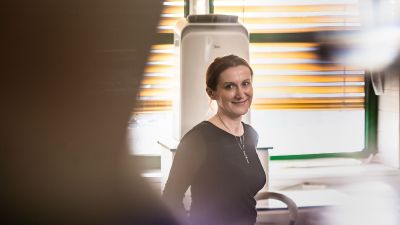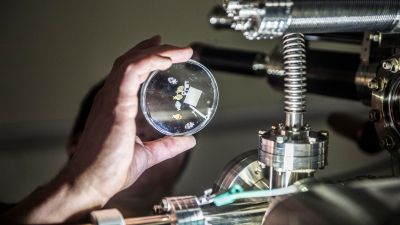"There's auxin in the cytoplasm! Root cells, I request an immediate stop," is how one of the latest results of the scientific team of Matyáš Fendrych from the Faculty of Science of the Charles University can be summarised tongue-in-cheek. They have succeeded in discovering a new signalling mechanism in the so-called fast auxin pathway. In another publication, also published a few days ago, they describe what it is actually good for.
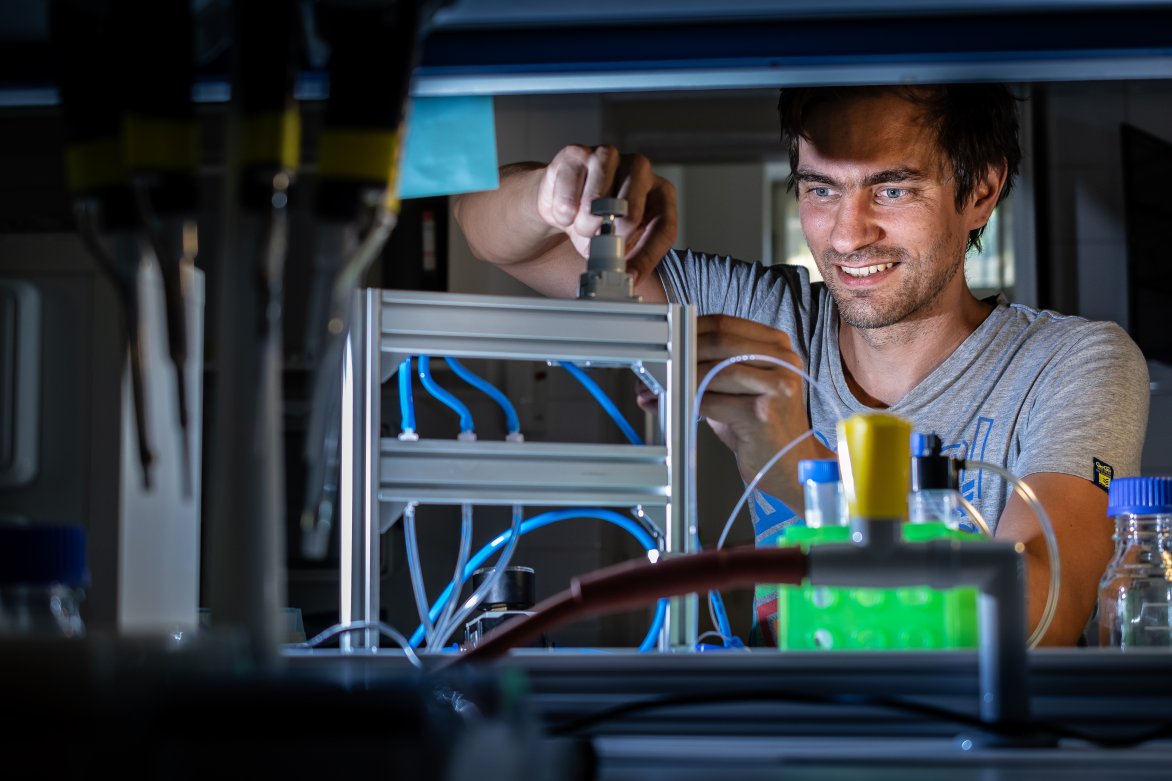
Molecular biologist Matyáš Fenrych always enjoys searching for the essence - what something is good for.
Although the plants appear immobile at first glance, there is a root sprint going on underground. "Root cells react to the plant hormone auxin within seconds, and in just a few minutes we can see the root tip wiggle," says Matyáš Fendrych, head of the research group at the Faculty of Science at Charles University. The fact that plant roots are actively moving in the soil is a well-known fact in itself - they anchor the plant and search for water and nutrients. "Unlike the movement of animals, the 'movement' of plants is made possible by growth, i.e. cell division and elongation. When a root wants to twist, it slows down cell elongation on one side, causing the root to bend. The Earth's gravitational field is their orientation signal as to where they are up and down," the biologist explains.
The detection of the direction of gravity takes place at the very tip of the root, but the bending itself occurs many cells further away. The root cells actively communicate with each other using the plant hormone auxin. "It's actually simple signalling, when the root cells get more auxin they slow down their elongation and vice versa. Plant roots detect the change in orientation in the gravitational field almost instantly, and within a few minutes, the bending of the root along the direction of gravity is noticeable. We have shown in previous studies that the growth response of roots to auxin is also almost instantaneous. What remained unanswered, however, was how the root cells perceive auxin and how the rapid response occurs," Fendrych describes the research questions for which he was awarded a prestigious European Research Council Starting grant (ERC Starting grant: CELLONGATE) in 2018 and internal support from UK Primus (2019).
"In the first paper by Dubey, Han et al. we describe how it works, what happens at the molecular level in roots. In the second by Serre, Werner et al. we discuss what it's all good for," says Fendrych. For their research, they use a unique vertical microscope combined with spinning disk technology, which allows them to observe the growth of the plant in its natural, i.e. vertical, position, and at the same time "live", as the spinning disk allows very fast scanning.

Illustrative image of the root tip of a plant Arabidopsis thaliana .
Reporting a turn
The first-mentioned publication, which appeared in the prestigious peer-reviewed journal Molecular Plant in July, focused on a protein called AFB1 (Auxin Signaling F-Box Protein 1), one of the receptors for auxin in the plant Arabidopsis thaliana - a model plant favored by geneticists. "The signalling pathway of these receptors is well known: the receptors are in the nucleus of the cell and when the hormone auxin binds, it triggers a signalling pathway that changes the expression of genes in the cell. However, AFB1 is special because it is found in the cytoplasm in addition to the cell nucleus. And we wondered why," says Matyáš Fendrych.
So they used the special microscopy mentioned above to measure the calcium level in the cytoplasm after the addition of auxin. "Both plant and animal cells use calcium ions for rapid signalling. The roots of normal plants respond to even low concentrations of auxin by immediately increasing the calcium concentration in the cytoplasm. This calcium 'wave' triggers a whole other signaling cascade that leads to a slowing of cell elongation and then bending of the root according to gravity," describes first author of the study Shiv Mani Dubey, who is from India and is finishing his Ph. D. in Fendrych's team. He also plans to continue his postdoctoral fellowship abroad, which this publication can greatly help him to do and "open doors" to top laboratories.
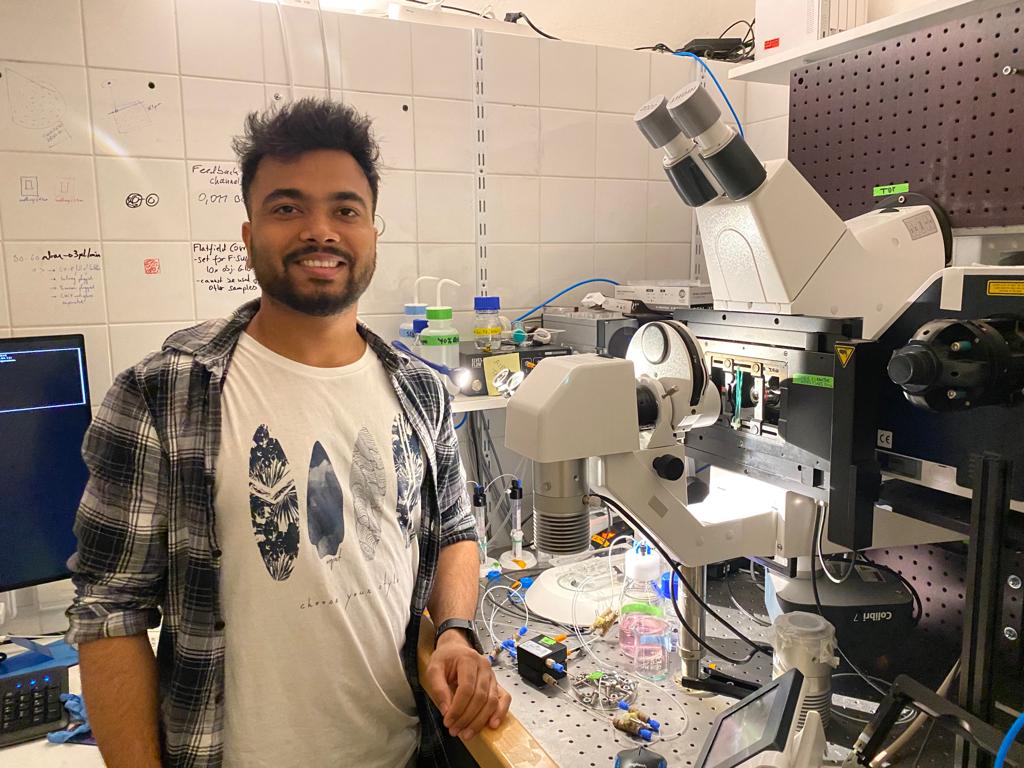
The order of the authors was decided by a dollar toss. Shiv Mani Dubey from Matyáš Fendrych's team was more lucky and became the first author.
"The roots of the plants we genetically engineered to lack the AFB1 receptor were 'blind' to auxin in the first few minutes - if the calcium concentration in the cytoplasm remains unchanged, the root does not respond. This shows that the AFB1 receptor is required to trigger the calcium signal. At the same time, normal plants are able to respond very quickly to a change in gravity (90 degree rotation) by changing the direction of growth. Roots without the AFB1 receptor respond significantly later because there is no calcium wave to trigger a rapid growth response. Even these mutant roots will eventually bend, but with a visible delay," says the PhD student, who was equally involved in the research with an American colleague. The order of the authors was decided by chance. "We tossed a dollar during an online call between Korea, the USA and Prague," shares Matyáš Fendrych, who, like the second leader, ended up in the second-to-last position.
And he adds how the whole collaboration between Professor Mark Estelle from the University of California San Diego, one of the best-known experts on the auxin pathway, who discovered the auxin recognition mechanism and became an icon of plant developmental genetics, and his Korean postdoc colleague Soeun Han came about. "We found that we were working on a similar topic. Instead of competing, we joined forces, which turned out to be a happy and very fruitful idea."
However, the international team was not satisfied with this result alone and continued to investigate the role of the AFB1 receptor in the cell nucleus and cytoplasm. "We were interested to see if their roles in the wound auxin response differed in any way. Using molecular tricks, we sent all the AFB1 protein either to the cell nucleus or all to the cytoplasm. We then measured its ability to trigger a rapid auxin response. To our surprise, only AFB1 located in the cytoplasm was able to repair the rapid auxin response in plants without AFB1. Thus, the sensing of auxin for rapid responses takes place in the cytoplasm of root cells," Fendrych describes the surprising result. The ultrafast response to auxin mediated by the AFB1 receptor and the calcium wave is essential for the root to be able to change direction rapidly and weave through soil particles in the hunt for water and nutrients. "In addition, we found that the signaling pathway controlled by the AFB1 protein negatively affects root branching. Yet root branching ensures soil colonization and is essential for plant survival. The significance of why and how exactly AFB1 is involved in root branching is still unknown," Fendrych outlines the future direction of the research.
Acidity has increased, let's grow
In a second publication, published a few days ago in the peer-reviewed journal eLife, the team from Faculty of Science of Charles University found a way to observe the concentration of protons, or acidity, on the surface of roots in real time. "When roots grow, their direction is determined by the gravitational field mentioned above. The growth itself takes place through cell elongation, which is controlled by a local drop in pH - acidification. In contrast, auxin inhibits root cell growth by increasing pH, but the exact mechanism of this auxin regulation remains unknown," says Fendrych. Root movement is determined by cell enlargement and elongation. Plant cells can be thought of as balloons that are held in shape by a very strong cell wall. At the same time, it must be very flexible and react quickly if it receives the signal 'acidity increases - we grow'.
"Using a new method of imaging and quantifying pH on the root surface, we discovered that the plant root exhibits distinct acidic and basic zones that are surprisingly controlled by the rapid auxin response and not just the previously assumed membrane proton ATPase," says the team leader, who described that there is an alkaline zone on the root surface that is maintained by auxin levels. "If this auxin signal drops, rapid acidification occurs, which is a clear signal for the cells to grow. The whole thing is very dynamic - when the root needs to turn, it becomes acidic on one side and remains alkaline on the other," explains Matyáš Fendrych, emphasizing that this further confirms the importance of the fast auxin pathway for the plant's interaction with its immediate environment.
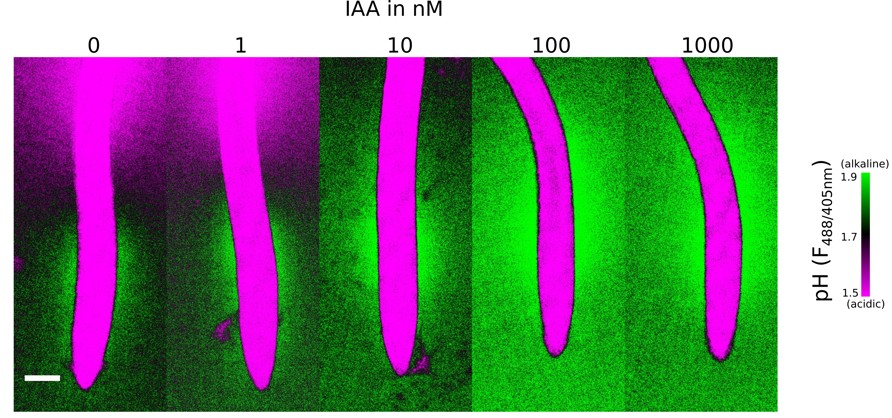
Illustrative image of the pH gradient around the root tip.
What's next? "There are still many unknowns. Auxin has been the star of research in the last decades, but that's a bit of a bias - whoever is researching a new mechanism is also focusing on the role of auxin, because we already know a lot about it, we can compare, and usually there is a link, because auxin has really important roles in plant growth and differentiation. But I'm always careful about this and ask whether the role of auxin is just secondary and we're missing the main point," says Matyáš Fendrych, who enjoys looking for the essence - what it's good for. "By discovering a completely unexpected role for the AFB1 receptor in the cytoplasm, we want to describe this signaling pathway in detail, because it must work in a completely different way, there must be some previously unknown cascade of responses. We are also interested in the effect of this signalling on root branching... There are many unknown and fascinating things," concludes the molecular biologist.


